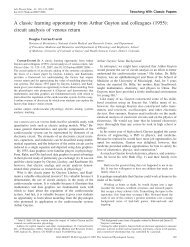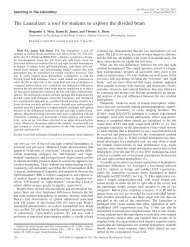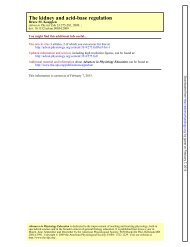construction of a model demonstrating neural pathways and reflex arcs
construction of a model demonstrating neural pathways and reflex arcs
construction of a model demonstrating neural pathways and reflex arcs
You also want an ePaper? Increase the reach of your titles
YUMPU automatically turns print PDFs into web optimized ePapers that Google loves.
#4<br />
I N N 0 V A T I 0 N S A N D IDEAS<br />
#2<br />
FIG. 19.<br />
Polysynaptic withdrawal <strong>reflex</strong> upon painful stimulus is illustrated. Arrange the 4 sheets <strong>of</strong> paper ln the order shown<br />
here. Trace the path <strong>of</strong> the <strong>reflex</strong> by following the numbered sheets clockwise. Sheet 1 contains the skin receptor that<br />
senses the painful stimulus. Sensory neuron extends from the skin receptor to the spinal cord illustrated on sheet 3.<br />
Sensory neuron synapses with an interneuron in the spinal cord at the S-l unit <strong>and</strong> with a second interneuron in the<br />
spinal cord at the S-2 unit. Interneuron from the S-2 unit passes its information to the ascending tract for pain <strong>and</strong><br />
temperature. S-4 unit is a synapse in the thalamus that continues to the cerebral cortex illustrated on sheet 2. The<br />
interneuron from the S-l unit synapses with the motor neuron at the S-3 unit on sheet 3. Motor neuron travels to the<br />
muscle effector shown in sheet 4, which allows an individual to pull away from the painful stimulus.<br />
underst<strong>and</strong>ing <strong>of</strong> <strong>neural</strong> <strong>pathways</strong> <strong>and</strong> the monosynap-<br />
tic <strong>reflex</strong>.<br />
Objectives<br />
On completion <strong>of</strong> this laboratory unit, students should<br />
be able to<br />
l Diagram <strong>and</strong> describe the <strong>neural</strong> <strong>pathways</strong> in-<br />
volved in the withdrawal <strong>reflex</strong> upon painful stimulus<br />
<strong>and</strong> the monosynaptic <strong>reflex</strong>/patellar tendon <strong>reflex</strong><br />
l Construct a working <strong>model</strong> <strong>of</strong> a monosynaptic<br />
<strong>reflex</strong> arc (knee jerk/patellar tendon <strong>reflex</strong>)<br />
l Use the <strong>model</strong> to explain what happens during the<br />
monosynaptic portion <strong>of</strong> the patellar tendon <strong>reflex</strong><br />
* Construct a working <strong>model</strong> <strong>of</strong> the withdrawal<br />
<strong>reflex</strong> upon painful stimulus<br />
l List the components <strong>and</strong> describe the function <strong>of</strong> a l Use the <strong>model</strong> to explain what happens at each<br />
monosynaptic <strong>reflex</strong> stage <strong>of</strong> the withdrawal <strong>reflex</strong> upon painful stimulus<br />
VOLUME 16 : NUMBER 1 - ADVANCES IN PHYSIOLOGY EDUCATION - DECEMBER 1996<br />
s35









